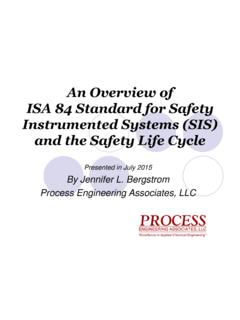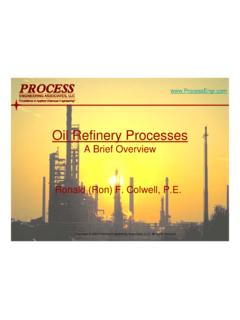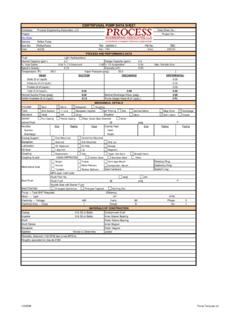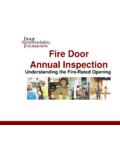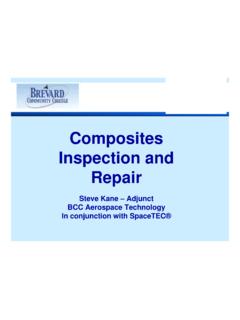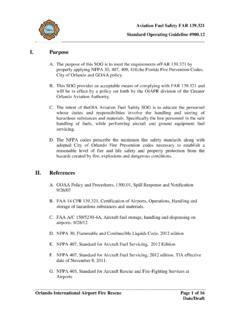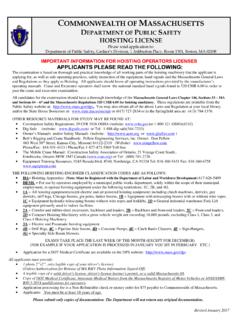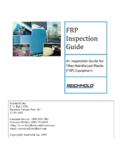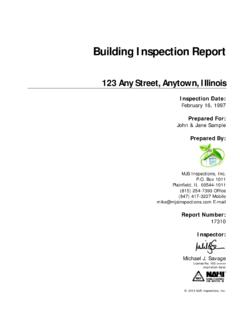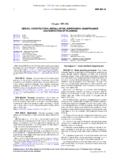Transcription of An Overview of ISA 84 Standard for Safety …
1 An Overview of ISA 84 standard for safety instrumented Systems (SIS). and the Safety life Cycle Presented in July 2015. By Jennifer L. Bergstrom Process Engineering Associates, LLC. ISA 84 Safety instrumented Systems and the Safety life Cycle Agenda: Safety components, acronyms, and definitions ANSI/ISA Standard for Safety instrumented Systems Safety life Cycle Incorporating Safety systems into process design Workshop Components, Acronyms, and Definitions Components: Safety instrumented Function (SIF). Safety instrumented system (SIS). Safety Integrity Level (SIL). Safety Requirement Specification (SRS). Safety life Cycle Independent Protection Layer (IPL). Components, Acronyms, and Descriptions SIF Safety instrumented Function Individual interlock or automatic trip function that is designed to alleviate or minimize an undesired hazard, as determined in the PHA/HAZOP and the SIL Selection/LOPA.
2 Includes all instrumentation in the interlock function, from the sensor and transmitter through the control system all the way to the final element ( , isolation valve). Components, Acronyms, and Descriptions SIS Safety instrumented system A critical system that consists of one or more automatic Safety instrumented Functions (SIFs) or interlocks Example: Fired Heater burner management system (BMS). FI- FALL SIS. 1. 100 100. Process flow H-1 SIS. 1. SIS. PAHH 1. 101. PI- XY- 101 102. Sweet fuel gas FC. Components, Acronyms, and Definitions SIL Safety Integrity Level Risk reduction levels: SIL RRF PFD (1/RRF). 0 0-10 10 1. 1 >10 to 100 10 2 to <10 1. 2 >100 to 1000 10 3 to <10 2. 3 >1000 to 10,000 10 4 to <10 3.
3 4 >10,000 to 100,000 10 5 to <10 4. Components, Acronyms, and Definitions SIL Safety Integrity Level Level of risk reduction that a SIF must achieve Target / Required SIL amount of risk reduction determined as a need during PHA / HAZOP and then the level is determined during a simplified SIL Selection or elaborate LOPA (Layer of Protection Analysis). Achieved / Verified SIL calculated risk reduction utilizing Markov equations and includes all components of the interlock to determine the level of risk reduction (RRF) or 1/PFD (Probability of Failure on Demand). Components, Acronyms, and Definitions SIL Safety Integrity Level Levels of risk: SIL 0 (none) tolerable risk SIL 1 minimal risk 95% of all SIL-rated interlocks SIL 2 medium risk Less than 5% of all SIL-rated interlocks SIL 3 high risk Less than 1% of all SIL-rated interlocks (typically found in the nuclear industry or off-shore platforms).
4 SIL 4 highest risk (not likely in petroleum or chemical industry). Components, Acronyms, and Definitions SRS Safety Requirement Specification Document containing detailed SIS interlock information Safety life Cycle . Activity designed to include all phases of the life of a SIF and SIS. KEY NOTE: It's not enough to just install a SIS. It must be properly designed and maintained so it is available when the need arises!!! ANSI/ISA 84 and Safety life Cycle were developed to guide a Safety system from the Risk Assessment cradle . to the Decommissioning grave . ANSI/ISA Standard for SIS. ANSI/ISA - Application of Safety instrumented Systems (SIS) for Process Industries : Follows IEC 61511.
5 First version in 1996. Second version approved in 2004 (included a Grandfather Clause ). OSHA recognizes this Standard as a RAGAGEP. Defines Safety instrumented system (SIS). Defines all phases required in Safety life Cycle ANSI/ISA 84 and Safety life Cycle Hazard & Risk Assessment Design cradle . (PHA, LOPA/SIL Analysis) (Execute &. Evaluate). Installation, Commission, & Validate Modification (FAT, SAT, Functional Proof Test). Operations Decommission and Maintenance grave . Why SIS and Safety life Cycle? Accidents/Incidents can and do occur, so in order to help minimize the frequency and/or severity - Safety instrumented Systems and Safety life Cycle are designed to minimize risk But if the Safety life Cycle is stopped, this could occur.
6 BP Refinery - Texas City Why SIS and Safety life Cycle? 15 fatalities and 180 injuries that day in 2005. Resulted in multitude of citations with a hefty fine of $21MM. 2009 Follow-up FTA inspection was conducted and $87MM fine was given; most of the FTAs related to PSVs and SIS. Why SIS and Safety life Cycle? Due to public concern over the severity of the 2005 BP. Texas City incident, OSHA initiated NEP (National Emphasis Program) inspections in petroleum refineries across the country in 2007. OSHA included SIS analysis in the NEP dynamic list for refineries (due to SIS and instrumentation failures considered as contributing causes of the BP incident). OSHA more recently initiated a nationwide NEP directive for chemical facilities with PSM-covered chemicals in late 2011.
7 Why SIS and Safety life Cycle? ANSI/ISA - Application of Safety instrumented Systems (SIS) for Process Industries: OSHA recognizes this Standard as RAGAGEP. (Recognized and Generally Accepted Good Engineering Practice) and has considered it to be within the scope of OSHA PSM. regulation under Mechanical Integrity (MI). Protection Layers IPL Independent Protection Layer Protective items, when used alone or in combination with diverse types, that are meant to reduce risk to personnel, the environment, or property Examples: BPCS (control system ), alarms and operator response, SIS, physical devices (PSVs, dual seals, dikes, flares, deluges, etc.), and other human mitigation (emergency response).
8 Protection Layers Process Hazards/Risk and IPLs (ups and downs). process risk BPCS. P. alarms R. O. SIS. C. Risk E. mechanical S. S. other tolerable Protection Layers Emergency Response (Plant and then Community). Mitigation (SIS, mechanical mitigation). Prevention (Alarms w/ intervention, mechanical protection). BPCS. PROCESS. Protection Layers / SIFs / SISs Safety systems/interlocks are a vital protection layer between the hazards of the process and the public when inherent design is not enough Safety Systems are added to the process design to minimize these risks to a tolerable level or ALARP (As Low As Reasonably Practical). Safety Systems Design Hazard & Risk Assessment Design cradle.
9 (PHA, LOPA/SIL Analysis) (Execute &. Evaluate). Installation, Commission, & Validate Modification (FAT, SAT, Functional Proof Test). Operations Decommission and Maintenance grave . Safety Systems Design SIF/SIS is added to a design during the cradle . stage or PHA as a safeguard to mitigate or minimize a hazard Each SIF is assigned a Safety Integrity Level (SIL) during the SIL Analysis or LOPA risk assessment SIL 0 lowest risk SIL 4 highest risk Each incremental SIL must be more reliable and available to operate when required (thus installation and maintenance costs increase). Safety Systems Design Requirements when designing SIS: Separation: Instrumentation interlock instrumentation CAN.
10 NOT be part of control logic Safety Control system requires Safety logic solver that segregates its inputs and outputs Robust equipment options: Examples: Honeywell ST3000 Safety transmitter with HART MAXON MM/MA series Safety isolation valves DeltaV Redundant SLS. Safety Systems Design Reliability and availability can also be achieved by: Architecture Using redundancy and voting logic of the initiators, Safety control system , and/or final elements ( , 1oo2, 2oo3 required to achieve safe state). Installation per manufacturer's guidelines Testing / Validation and Replacement both at initial startup as well as at specified testing intervals or after any modification ( , via PSSR). Safety Systems Design When designing or modifying a SIS, keep in mind there are two types of failures: Safe Failures Dangerous Failures Safe Failures are the desired failure Initiated (actual event).
